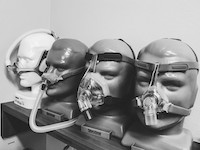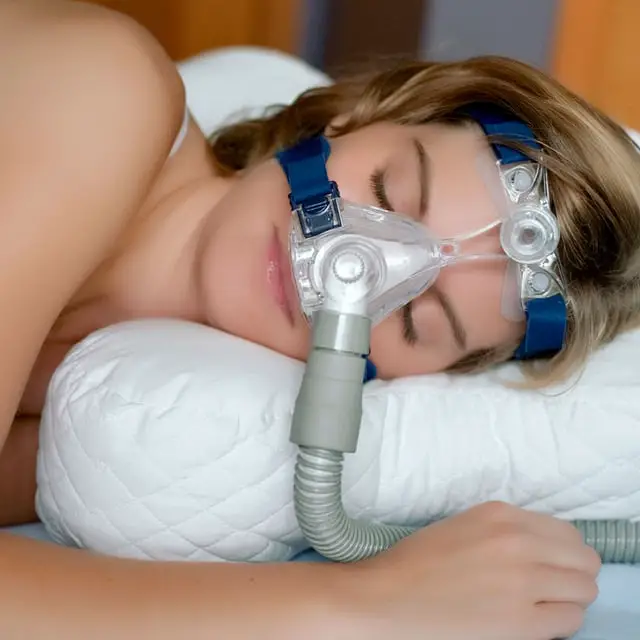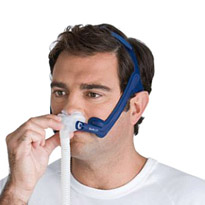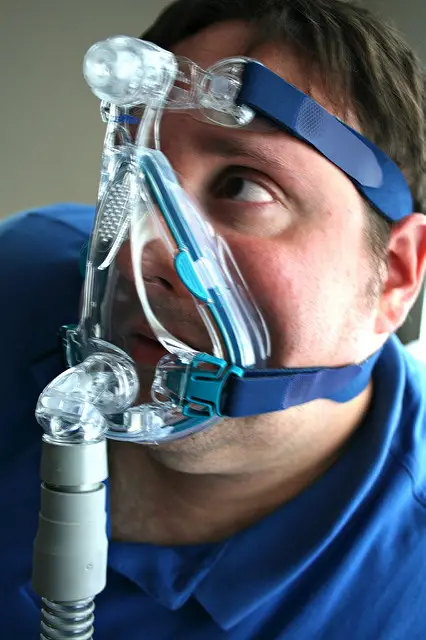As discussed in my post about sleep apnea and CPAP therapy, CPAP machines work by delivering constant air pressure to a patient’s airways via tubing connected to a mask strapped over the face.
A CPAP machine can be of type APAP machine or BiBAP machine.
Masks come in a variety of shapes and sizes, and it is advised for patients to work with their sleep doctor to find what fits best for them.
Table of Contents
Nasal masks
Many consider nasal masks to be the best CPAP mask for side sleepers. They cover the whole nose, from the bridge to the nostrils and upper lip.
Air is delivered indirectly to the airways via the nose. Therefore, nasal masks typically require higher pressure settings.
There is a large variety of options of nasal masks, and they come in many styles and sizes.
In terms of general size and bulkiness, these masks are a good compromise between the large, bulky full-face mask and the small nasal pillow.
These masks are an ideal choice for patients who:
- Breathe through their nose while they sleep
- Often move around in their sleep
- Are side-sleepers
- Use higher air pressure settings on their CPAP machine
| Pros | Cons |
| Natural airflow through the nose | Some report irritation on forehead or bridge of nose due to pressure of the mask |
| Better for higher pressure settings compared to nasal pillows |
Not the best for mouth breathers, unless used with a chin strap that keeps the jaw and mouth closed |
| Variety of styles and sizes | Not effective if patient has blocked sinuses |
| Best for side-sleepers | Not ideal for patients with altered nasal structure (eg, deviated septum) |
What is BiBAP Machine? Why iBreeze BiPAP Machine is the best home choice?
Nasal pillows
Many also consider nasal pillows to be the best CPAP mask for side sleepers. Also called nasal cushions, these masks are the smallest and most lightweight option for patients.
They provide a seal around each nostril and supply air directly through the nostrils, and are often attached to headgear that straps around the top, back of the head.
This design allows for the least amount of contact with the face.
Nasal pillows work best at low to moderate air pressure settings. Since air is supplied directly through the nostrils, high pressure settings can cause discomfort in the nose.
These masks are an ideal choice for patients who:
- Breathe through their nose while they sleep
- Often move around in their sleep
- Are side-sleepers
- Have beards/considerable facial hair
- Wear glasses
- Experience particular discomfort or claustrophobia with larger CPAP masks
| Pros | Cons |
| Lightweight and provide minimal contact with the face |
Not ideal of patients who require higher pressure settings |
| Minimize air leakage since air is supplied directly through nostrils |
Patients may experience nosebleeds or nasal dryness |
| Block vision less compared to nasal masks or full-face masks |
Not ideal for mouth breathers (unless used with a chin strap) |
APAP Machine. What’s the difference between APAP Machines and CPAP Machines?
Full-face masks
Full-face masks are the best CPAP mask for open mouth breathers.
They cover both the nose and the mouth, and they take up a large area of the patient’s face. Side straps on the mask help to keep it in place on the face.
Full-face masks typically require higher pressure settings, as air is supplied indirectly to the nose and mouth.
These masks are an ideal choice for patients who:
- Require high pressure settings on their CPAP machine
- Breathe through their mouth while they sleep
- Sleep on their back
- Have frequent congestion (eg, allergies or cold symptoms) that make it hard for them to breathe through their nose
| Pros | Cons |
| Provide greater surface area to supply air at high pressure, making the pressure seem less direct and more tolerable |
Blocks vision more compared to other types of masks |
| Good for patients who sleep on their back since there is optimal air seal in this position |
Not ideal of patients who wear glasses as they cover the bridge of the nose |
| Extra support and straps for patients who move around frequently in their sleep |
Not ideal for stomach- or side-sleepers since bulkiness of mask may cause it to be displaced during sleep |
| Higher chance of air leakage due to larger surface area |
|
| Dry eyes due to leakage from top of mask |
How to Pick the Right size?
The mask is chosen correctly if:
- There are no air leaks from under it or are within the permissible norm;
- The device does not put pressure on the face and does not move from the head in the supine position;
- In the morning after the end of therapy, there is no constant nasal congestion, dryness and burning sensation in the upper respiratory tract.
If you want to purchase a new mask to replace a worn one, then you can choose the same model, provided that it was comfortable to use.
Doctors advise choosing 2 different types of masks so as not to stop CPAP therapy if one accessory becomes unusable, including due to a cold (a nasal or cannula mask should be replaced if nasal congestion occurs).
My Closing points
Size, fit, comfort, and sleeping position (eg., if you are a side-sleeper) are extremely important for selecting the right CPAP mask for sleep apnea patients.
If these factors are not right, or they do not address a patient’s breathing requirements, patients can become non-compliant with their CPAP therapy.
For these reasons, patients need to be educated about their CPAP therapy and their mask options. It is crucial for patients to know what their options are to:
- Better help themselves
- Have a more fruitful conversation with their physician about finding the mask that works best for them
References
- American Association of Sleep Technologists. Which CPAP mask is best for your patient? Pros & cons of various mask types. https://www.aastweb.org/blog/cpap-masks-options-full-face-nasal-and-nasal-pillows. Published December 20, 2017. Accessed January 2022.
- American Sleep Apnea Association. Choosing a mask. https://www.sleepapnea.org/treat/cpap-therapy/choosing-a-mask/. Accessed January 2022.
- Philips Respironics. How to choose a CPAP mask. https://www.sleepapnea.com/products/masks/how-to-choose/. Accessed January 2022.
- Mayo Clinic. Slide show: which CPAP masks are best for you? https://www.mayoclinic.org/diseases-conditions/sleep-apnea/multimedia/cpap-masks/sls-20076986. Published December 7, 2015. Accessed January 2022.
Images courtesy of Flickr.




